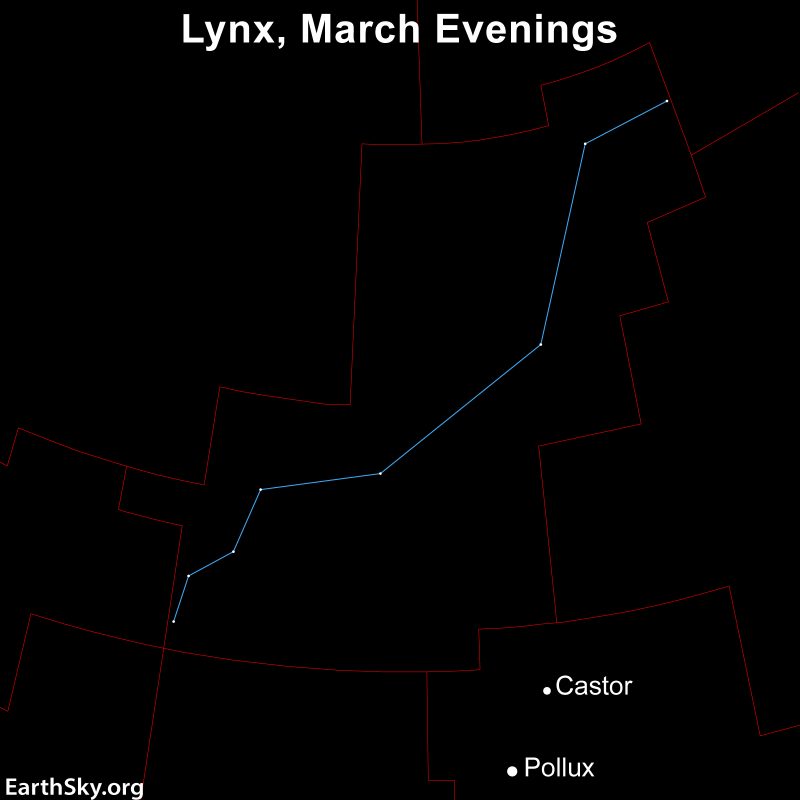
The constellation of the Lynx, named for the wild cat, may be dim, but it holds a few notable deep-sky objects, including the strange globular cluster known as the Intergalactic Wanderer. March is a great time to view Lynx when it’s positioned high in the sky, passing overhead for those in the Northern Hemisphere. Learn more about the constellation’s stars and how to find it.
The creation of the constellation Lynx
The Lynx is another constellation, similar to Lacerta and Leo Minor, that astronomer Johannes Hevelius created out of the vast darkness between major constellations in the late 1600s. Hevelius supposedly named this smattering of dim stars for a lynx, due to its fine eyesight. It would take someone with equally fine eyesight to discern the form of a lynx here.
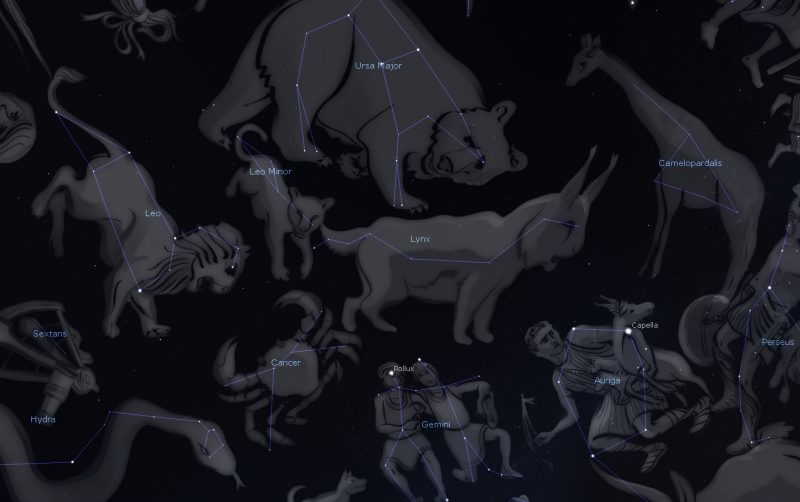
Finding the constellation Lynx
The Lynx is located between well-known constellations. Look for it in front of the nose and front paws of Ursa Major, the Great Bear. On the opposite side from Ursa Major, Lynx is bordered by Castor and Pollux the Twins and Auriga the Charioteer with its brilliant star Capella. If you can find Ursa Major and Auriga, the quiet dark space between them is the home of the Lynx.
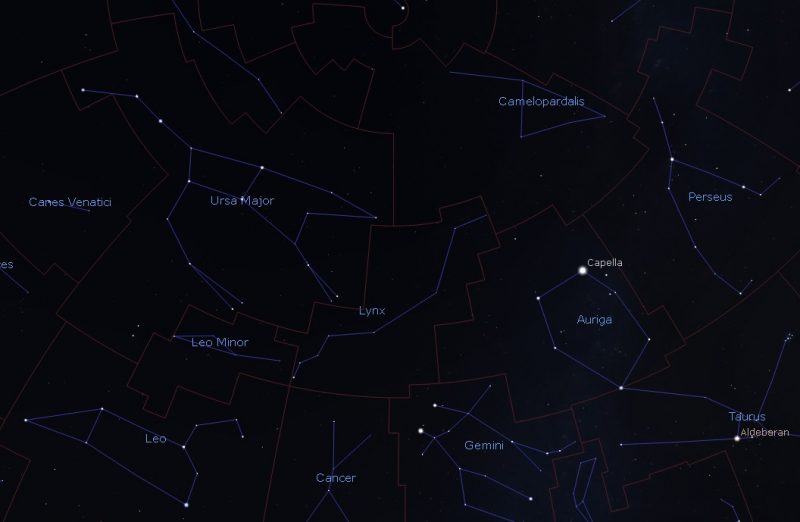
The stars of the Lynx
The two brightest stars in Lynx lie together in the very corner of the constellation. Find them under Ursa Major’s front paws and above the head of Leo the Lion. The star closer to Leo is Alpha Lyncis at magnitude 3.14. It lies 222 light-years away. The star above it, at magnitude 3.82, has the designation 38 Lyncis. It lies at a distance of 122 light-years from us.
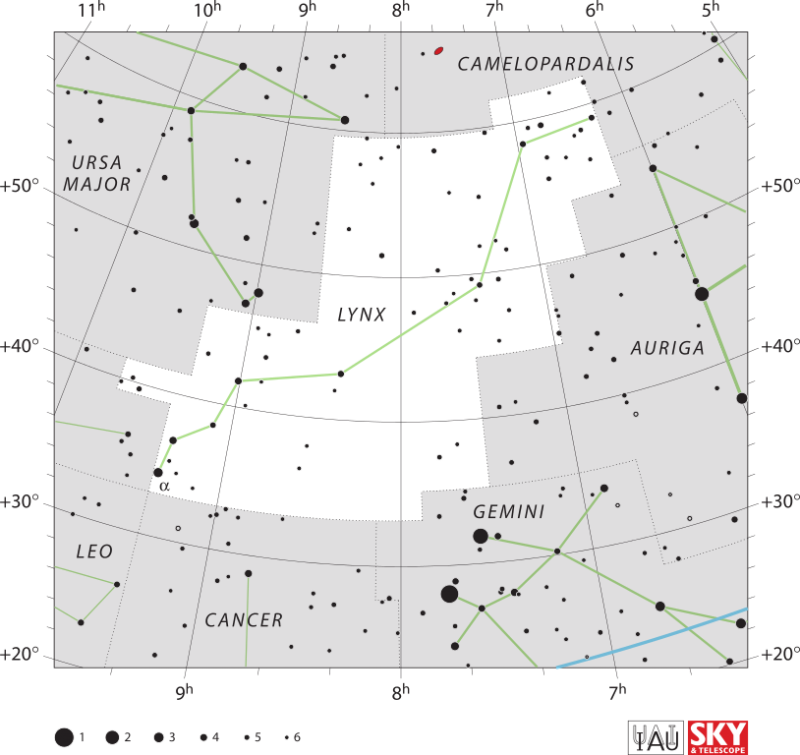
Galaxies in the constellation Lynx
The brightest galaxy in Lynx is about six degrees from the stars Alpha and 38 Lyncis. Look in the direction of Castor and Pollux in Gemini. This galaxy, NGC 2683, also lies straight up from the constellation Cancer. If you extend a line from the Beehive Cluster at the center of Cancer through the star Iota Cancri, you’ll come to NGC 2683 just across the border in Lynx. NGC 2683 has a magnitude of 9.69 (seeing it requires at least a medium-sized telescope) and lies 16 million light-years away. This spiral galaxy, which bears the nickname the UFO Galaxy, is oriented nearly edge-on from our perspective.

Another notable galaxy, near the center of the constellation, is the Bear Paw Galaxy, or NGC 2537. It’s a challengingly faint dwarf galaxy with a magnitude of 11.7. It consists of a half circle shape with a line sticking out of it. Does it look like a bear’s paw to you?
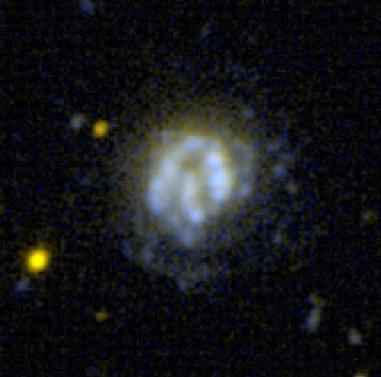
The Intergalactic Wanderer
The last deep-sky target we’ll cover in Lynx is the Intergalactic Wanderer, NGC 2419. It lies seven degrees from the star Castor, when heading north in the direction of Polaris. The Intergalactic Wanderer is a globular cluster shining at magnitude 10.4. You will need a large telescope to see it. An unnamed magnitude 7.2 star lies beside NGC 2419.
This globular cluster got its name because it’s at such a tremendous distance from us; approximately 300,000 light-years away. Normal globular clusters are huge groupings of stars that are gravitationally bound to a galaxy and rotate around it, outside of the central region of a galaxy.
But the Intergalactic Wanderer is even farther away from the Milky Way than some of our galaxy’s satellite galaxies, such as the Magellanic Clouds. Therefore, the Intergalactic Wanderer seems to be near the theoretical limit for globular clusters bound to our galaxy.

Bottom line: The constellation Lynx represents a cat and passes high overhead in March skies for the Northern Hemisphere. Learn its stars and deep-sky objects.
The post Meet the constellation Lynx, overhead in March first appeared on EarthSky.
0 Commentaires